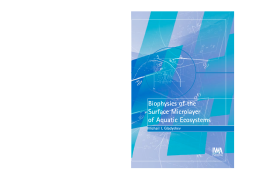
Additional Information
Book Details
Abstract
Biophysics of the Surface Microlayer of Aquatic Ecosystems introduces the concept of the surface film, or microlayer, of natural water bodies as a specific biophysical environment. The book investigates the hydrophysics, physical chemistry, hydrochemistry and hydrobiology of the surface microlayer in detail. Biophysics of the Surface Microlayer of Aquatic Ecosystems fills the existing gaps in the literature that exist between studies of the surface film by hydrophysicists, hydrochemists and hydrobiologists, by introducing essential physical surface film phenomena to biologists, and biological surface film phenomena to physicists. This book is thus a valuable and unique reference work for oceanologists and limnologists around the world. Contents Introduction: Surface films and microlayers Thermophysics of the surface film of water Aeration through the surface film Films of surfactants at the water surface Hydrochemistry of the surface microlayer of natural water bodies Neustonology Conclusion
Table of Contents
| Section Title | Page | Action | Price |
|---|---|---|---|
| Contents | vi | ||
| Acknowledgements | ix | ||
| Preface | x | ||
| 1. Introduction: Surface films and microlayers | 1 | ||
| 2. Thermophysics of the surface film of water | 5 | ||
| 2.1. Methods of temperature measurement in the surface film | 5 | ||
| 2.2. Profile of temperature in the surface film. | 7 | ||
| 2.3. Heat balance of the water surface | 10 | ||
| 2.3.1. Heat balance equation | 10 | ||
| 2.3.2. Influence of air temperature and humidity on the temperature of the surface film | 11 | ||
| 2.3.3. Effect of wind on the temperature of the surface film | 15 | ||
| 2.4. Descent of cold thermals | 16 | ||
| 2.5. Résumé: Temperature | 19 | ||
| 3. Aeration through the surface film | 21 | ||
| 3.1. The Whitman film model and surface-renewal models | 21 | ||
| 3.2. Experimental values of the oxygen transfer coefficient and the diffusion layer thickness | 24 | ||
| 3.3. Influence of the wind on the oxygen transfer rate | 25 | ||
| 3.4. Influence of the surface film temperature on the oxygen transfer rate | 27 | ||
| 3.5. The descent of cold thermals and gas transfer | 28 | ||
| 3.6. Résumé: Aeration | 29 | ||
| 4. Films of surfactants at the water surface | 31 | ||
| 4.1. Fundamentals of physical chemistry of surfactant films | 31 | ||
| 4.1.1. Adsorption | 32 | ||
| 4.1.2. Surface films of poorly soluble materials | 34 | ||
| 4.1.2.1. Sizes of molecules, film structure and surface pressure | 34 | ||
| 4.1.2.2. Force-area isotherms | 35 | ||
| 4.2. Surfactant films on natural water bodies | 38 | ||
| 4.2.1. Force-area isotherms of natural surface films | 38 | ||
| 4.2.2. Slicks | 43 | ||
| 4.2.3. Surface pressure | 44 | ||
| 4.3. Effect of surfactant films on the physical properties of the water surface | 46 | ||
| 4.3.1. Retention of evaporation | 46 | ||
| 4.3.2. Influence of surfactant films on the temperature of the surface film of water | 47 | ||
| 4.3.3. Influence of surfactant films on aeration | 52 | ||
| 4.4. Résumé: Surfactant films | 56 | ||
| 5. Hydrochemistry of the surface microlayer of natural water bodies | 57 | ||
| 5.1. Methods of sampling the SML | 58 | ||
| 5.1.1. Net screen | 58 | ||
| 5.1.2. Glass plate | 60 | ||
| 5.1.3. Rotating drum | 61 | ||
| 5.1.4. Comparison of the three SML samplers | 62 | ||
| 5.2. Unusual features of the hydrochemical composition of the surface microlayer | 65 | ||
| 5.2.1. Organic carbon and nutrients | 65 | ||
| 5.2.2. Trace metals | 67 | ||
| 5.2.3. Components of anthropogenic origin | 69 | ||
| 5.3. Composition of organic matter of the surface microlayer | 69 | ||
| 5.3.1. Lipids | 70 | ||
| 5.3.2. Macromolecular substances | 72 | ||
| 5.4. Input and output of material to and from the surface microlayer | 73 | ||
| 5.5. Fatty acids as identified chemical species in the surface microlayer | 77 | ||
| 5.5.1. Fatty acid composition of the surface microlayer | 78 | ||
| 5.5.2. Sources of fatty acids of the surface microlayer | 78 | ||
| 5.5.3. Fatty acids as ecological biomarkers | 79 | ||
| 5.6. Résumé: Hydrochemistry | 82 | ||
| 6. Neustonology | 85 | ||
| 6.1. Marine neustonology | 86 | ||
| 6.1.1. Marine bacterioneuston | 86 | ||
| 6.1.1.1. Enrichment and problems of sampling, counting and location of bacteria in the surface microlayer | 86 | ||
| 6.1.1.2. Resistance, activity and the other probable causes of enrichment of bacteria in the surface microlayer | 95 | ||
| 6.1.2. Marine phytoneuston | 101 | ||
| 6.1.3. Marine zooneuston | 105 | ||
| 6.1.3.1. Zaitsev’s approach to the marine zooneuston | 105 | ||
| 6.1.3.2. Species composition, ecological groups and life forms | 108 | ||
| 6.1.3.3. Distribution of zooneuston | 114 | ||
| 6.1.3.4. Zooneuston as an indicator of pollution | 115 | ||
| 6.2. Freshwater neuston | 115 | ||
| 6.2.1. Freshwater bacterioneuston | 116 | ||
| 6.2.2. Freshwater phytoneuston | 119 | ||
| 6.2.3. Freshwater zooneuston | 120 | ||
| 6.3. Potential role of neuston in heat and mass exchange between the atmosphere and a reservoir | 125 | ||
| 6.4. Résumé: Neustonology | 127 | ||
| 7. Conclusion | 129 | ||
| References | 132 | ||
| Index | 143 |
